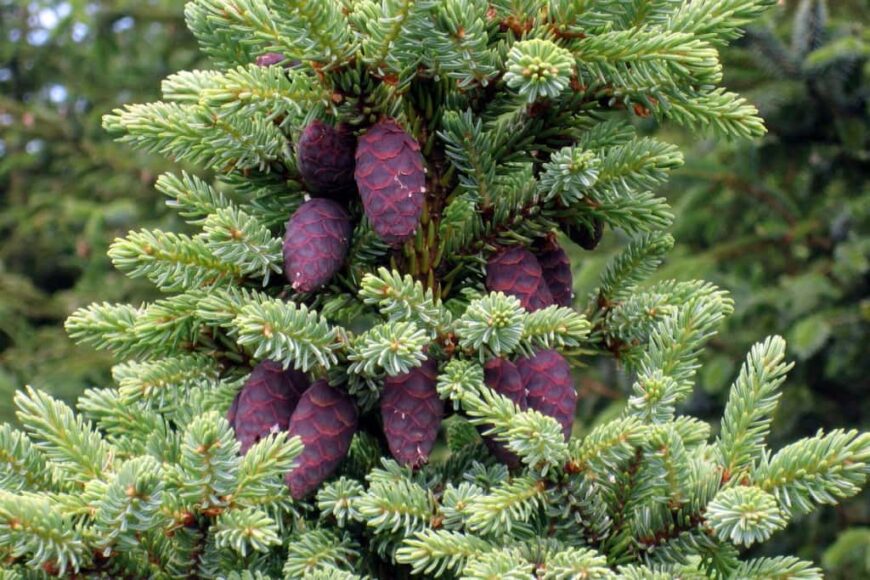
 Name: Black Spruce
Name: Black Spruce Family: Pinaceae
Family: Pinaceae Origins: Native to the northern regions of North America, including Alaska, Canada, and parts of the northern United States.
Origins: Native to the northern regions of North America, including Alaska, Canada, and parts of the northern United States. Humidity: Black spruce prefers moist to wet environments.
Humidity: Black spruce prefers moist to wet environments. Location: Primarily found in the boreal forest.
Location: Primarily found in the boreal forest. Soil: Thrives in nutrient-poor soils, including acidic, peat-based, and poorly drained soils.
Soil: Thrives in nutrient-poor soils, including acidic, peat-based, and poorly drained soils. Pests and diseases: Susceptible to insect pests such as spruce budworm and spruce beetle. Diseases include needle cast, rust, and canker.
Pests and diseases: Susceptible to insect pests such as spruce budworm and spruce beetle. Diseases include needle cast, rust, and canker. Care: Requires minimal care once established. Regular watering during dry periods and protection from pests and diseases are important.
Care: Requires minimal care once established. Regular watering during dry periods and protection from pests and diseases are important. Height of growth: Can reach heights of up to 25 meters (80 feet).
Height of growth: Can reach heights of up to 25 meters (80 feet). Planting in the soil: Plant in a location with good drainage, and ensure the soil is acidic and moist. Best planted in spring or fall.
Planting in the soil: Plant in a location with good drainage, and ensure the soil is acidic and moist. Best planted in spring or fall. Blooming: Black spruce produces small, inconspicuous flowers in spring.
Blooming: Black spruce produces small, inconspicuous flowers in spring.The black spruce (Picea mariana) is a coniferous tree native to the northern regions of North America, particularly the boreal forest. Known for its resilience and adaptability to harsh environmental conditions, the black spruce plays a vital role in the ecosystem and offers numerous benefits to both nature and humans. This brief explores the key characteristics, ecological significance, and human uses of the black spruce.
Content:
Description and Distribution:
Physical Characteristics
The black spruce is a medium-sized evergreen tree that can reach heights of up to 25 meters (80 feet) and has a narrow, conical shape.
It features short, stiff needles that are typically dark green or bluish-green in color. The tree’s bark is thin, scaly, and dark brown in color.
Distribution
This tree species is most commonly found in the boreal forest, spanning regions such as Alaska, Canada, and parts of the northern United States.
Black spruce trees are well adapted to the cold climates and nutrient-poor soils of these northern regions.
Ecological Importance:
Adaptations to Harsh Environments
The black spruce has several adaptations that allow it to thrive in harsh environmental conditions, including cold temperatures, nutrient-poor soils, and wildfires.
It has a shallow root system that spreads widely to maximize water and nutrient uptake.
Wildlife Habitat and Food Source
Black spruce trees provide important habitat and food sources for various wildlife species in the boreal forest.
The dense foliage offers nesting sites for birds and small mammals, while the tree’s seeds are consumed by animals such as squirrels, grouse, and songbirds.
Carbon Sequestration and Climate Change
Black spruce forests play a significant role in mitigating climate change by sequestering carbon dioxide (CO2) from the atmosphere.
The trees store carbon in their wood, helping to reduce greenhouse gas concentrations and combat global warming.
Environmental Benefits:
Soil Stabilization
The extensive root system of black spruce helps stabilize soil and prevent erosion, particularly in wetland areas.
Their presence helps maintain the integrity of delicate ecosystems such as peatlands and muskegs.
Water Regulation
Black spruce forests act as a natural sponge, regulating water flow and maintaining water quality in watersheds.
They help control runoff, reduce flooding, and contribute to the overall health of aquatic ecosystems.
Human Uses:
Indigenous Uses
Historically, indigenous communities have relied on black spruce for various purposes.
It has been used in the construction of shelters, canoes, and tools, and for medicinal and spiritual practices.
Commercial Uses
The wood of black spruce is commercially valuable and used in the production of lumber, pulp, and paper products.
The tree’s resin can be extracted and used in the manufacturing of varnishes, adhesives, and perfumes.
Frequently Asked Questions (FAQs):
What are the main characteristics of black spruce needles?
Black spruce needles are short, stiff, and typically dark green or bluish-green in color.
Where is the black spruce primarily found?
The black spruce is primarily found in the boreal forest, spanning regions such as Alaska, Canada, and parts of the northern United States.
How do black spruce trees contribute to carbon sequestration?
Black spruce trees store carbon dioxide (CO2) from the atmosphere in their wood, helping to reduce greenhouse gas concentrations and combat global warming.
What ecological benefits do black spruce forests provide?
Black spruce forests help stabilize soil, prevent erosion, regulate water flow, and maintain water quality in watersheds. They also provide habitat and food sources for various wildlife species in the boreal forest.
How have indigenous communities traditionally used black spruce?
Indigenous communities have historically used black spruce for constructing shelters, canoes, and tools. It has also been used for medicinal and spiritual practices.
What are the commercial uses of black spruce?
The wood of black spruce is commercially valuable and used in the production of lumber, pulp, and paper products. The tree’s resin can be extracted and used in the manufacturing of varnishes, adhesives, and perfumes.

